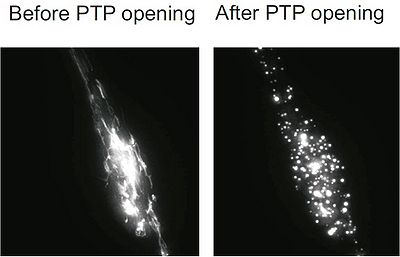Chinopoulos C 2012 Abstract Bioblast
| Doczi J, Aniko Gal A, Echaniz-Laguna A, Mousson de Camaret B, Molnar MJ, Adam-Vizi V Chinopoulos C (2012) Properties of the mitochondrial permeability transition in human cells lacking the adenine nucleotide translocase isoform 1. Mitochondr Physiol Network 17.12. |
Link: MiPNet17.12 Bioblast 2012 - Open Access
Doczi J, Gal A, Echaniz-Laguna A, Mousson de Camaret B, Molnar MJ, Adam-Vizi V, Chinopoulos C (2012)
Event: Bioblast 2012
In pathological conditions, mitochondria recruit proteins to the inner membrane to form a pore that disrupts membrane integrity. This pore, termed permeability transition pore (PTP) is of a sufficient size to allow the passage of solutes and water since the mitochondrial matrix is hyperosmotic to the cytosol that may also result in rupture of the outer membrane [1]. For long, the adenine nucleotide translocase (ANT) was suspected to be a structural component of the pore; however, recent experiments showed that mitochondria obtained from ANT knock out mice were still capable of demonstrating pore formation; it was therefore, inferred that ANT modulates the opening of the mitochondrial permeability transition pore, but it is not a structural element per se [2]. Hereby we investigated the properties of in situ permeability transition in human fibroblasts obtained from a patient with a complete absence of ANT isoform 1. In situ fibroblast mitochondria of the patient and a disease-free related individual were visualized by mito-DsRed2 targeting and challenged by calcimycin. The effects of glucose, NaCN, and an uncoupler were evaluated by measuring mitochondrial volume using the thinness ratio technique. The absence of ANT1 abolished the hastening of the swelling of in situ mitochondria by glucose deprivation and NaCN co-application, upon calcimycin exposure. As expected, the extent of swelling quantitated by the thinness ratio technique was the same for both cell types. The impact of a lack of an electrochemical gradient substantiated by absence of glucose and presence of cyanide predisposing to pore opening is therefore mediated by ANT1.
- Azzolin L, von Stockum S, Basso E, Petronilli V, Forte MA, Bernardi P ( 2010) The mitochondrial permeability transition from yeast to mammals. FEBS Lett 584: 2504-2509. Open Access
- Kokoszka JE, Waymire KG, Levy SE, Sligh JE, Cai J, Jones DP, MacGregor GR, Wallace DC (2004) The ADP/ATP translocator is not essential for the mitochondrial permeability transition pore. Nature 427: 461-465. Open Access
• Keywords: Permeability transition pore, ANT
• O2k-Network Lab: HU Budapest Chinopoulos C
Labels: MiParea: Genetic knockout;overexpression
Stress:Permeability transition Organism: Human Tissue;cell: Fibroblast
Enzyme: Adenine nucleotide translocase Regulation: Ion;substrate transport
Affiliations and author contributions
Judit Doczi(1), Aniko Gal(2), Andoni Echaniz-Laguna(3), Benedicte Mousson de Camaret(4), Maria J Molnar(2), Vera Adam-Vizi(1) and Christos Chinopoulos(1)
(1) Department of Medical Biochemistry, Semmelweis University, Budapest, Hungary; Email: [email protected]
(2) Clinical and Research Center for Molecular Neurology, Department of Neurology, Semmelweis University, Budapest, Hungary
(3) Departement de Neurologie, Hopitaux Universitaires, Hopital de Hautepierre, Strasbourg cedex, France
(4) Service des Maladies Hereditaires du Metabolisme, Centre de Biologie et de Pathologie Est, CHU Lyon, Bron, France
Figure 1
mito-DsRed2 targeting of fibroblast mitochondria reveals in situ permeability transition.

